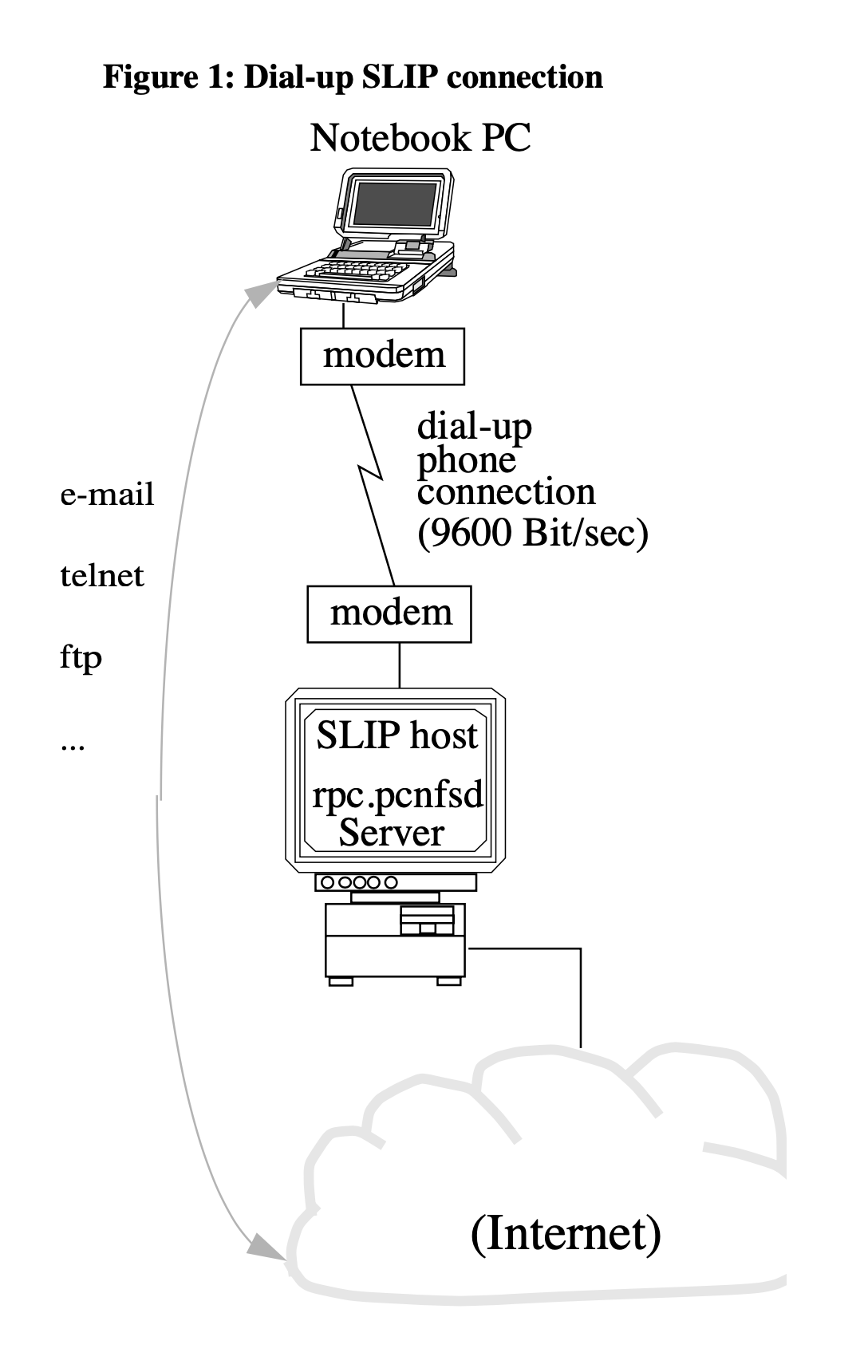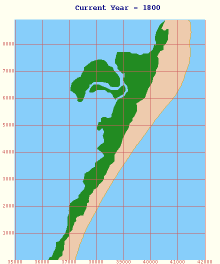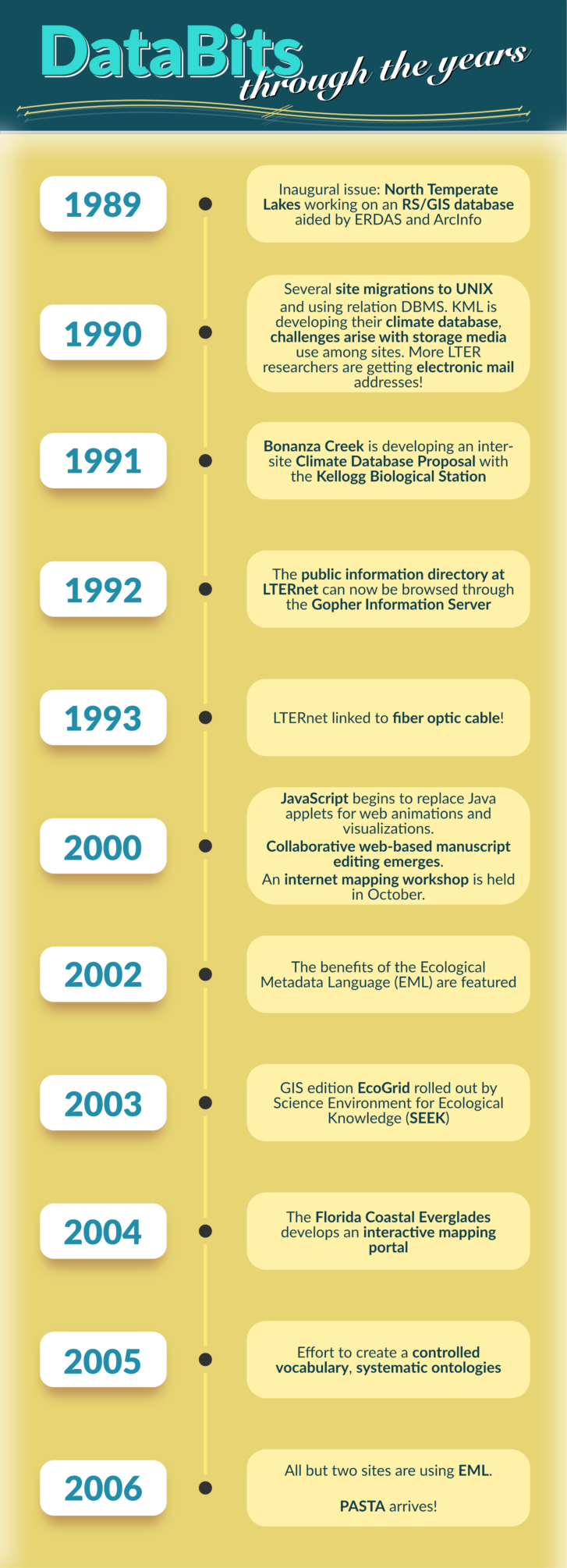
The premier issue of DataBits was published in 1989 to disseminate data management news between data managers, PIs, and the broader LTER community. Over 30 years later, data managers Hsunyi Hsieh (KBS) and Mary Marek-Spartz (MSP) take a look back at “vintage” DataBits articles, highlight their main topics, and provide retrospective commentary on the major developments in the LTER IM network over the years. Make sure to check out the infographic at the bottom, too! Review the entire archive of DataBits stories and issues on the lternet.edu website.
Fall 1989
The first DataBits issue contained a range of articles centered around emerging GIS technology. Students led by Tom Lillesand worked on developing the NTL-LTER RS/GIS database. The NTL RS/GIS workstation is equipped with ERDAS and Arcinfo. “Incorporating Remote Sensing and GIS Technology in Long-Term and Large-Scale Ecological Research” by T. M. Lillesand, M. D. MacKenzie, J. R. Vande Castle, and J. J Magnuson was presented at GIS/LIS ’89.
Hsieh note: it looks like a Local Area Network (LAN) was first up and running at the Konza Prairie LTER. A Sun 4/100 System (Sun would eventually be bought by Oracle) was in use across LTER sites for data management and RS/GIS uses.
Summer 1990
NWT had previously stored data on magnetic tape or floppy disks for multiple years, which posed a difficult situation for data users. In this issue, they revealed their new climate database, which allowed easy data access, analysis and visualization. PCs and modems were spread out at the Mountain Research Station and everyone had had an email address for some time. One data manager was impressed with ‘INGRESS’ database management tool, which allowed interactive SQL, PC-to-host connection, ai-based query optimizer, 4gl language, and much more (The data manager was considering purchasing this software).
The LTER Coordinating Committee Meeting raised discussions of LTER accomplishments in the 80s, the Core Data Set Catalog, the expansion of LTER to an Antarctic site, properties right to LTER data, and the LTER data sharing and access policy. The official data policy discussion was scheduled to continue at the LTER Data Managers’ meeting in Snowbird Utah.
The Classification Society of North America is mentioned as an organization dedicated to promoting the study of classification and clustering.
Hsieh note: I found this piece of information interesting because deep learning and AI today rely on classification and clustering algorithms.
Fall 1990
This edition focused on developing protocols for the storage/archival of LTER Core Data Sets.
Different storage media were used among 10 sites: 5 used hard disks (sometimes in a network environment), one used 9-track magnetic tape, one used floppy disks and magnetic tape, and 4 had some data on hard disks and some on magnetic tape.
Marek-Spartz note: meanwhile the World Wide Web was born with Tim Berners-Lee at CERN publishing the HTTP in November (the same day I was born!).
Spring & Summer 1991
This issue had site news updates. For example, BNZ was developing an inter-site Climate Database proposal with the KBS site.
Hsieh note: This could be one of the latest data storage news. https://www-popsci-com.cdn.ampproject.org/c/s/www.popsci.com/technology/5d-disc-stores-500-tb-of-data/?amp
1992
From the fall edition of Databits: “The public information directory at LTERnet can now be browsed through the Gopher information server”
Marek-Spartz note: this article contains descriptions on how to browse LTER files and directories on the Gopher protocol. Developed at the University of Minnesota (the home institution of CDR and MSP), Gopher had the potential to be the internet protocol of the world wide web if a few decisions were made differently. It was displaced by the hypertext transfer protocol in the 90s. For more on this: https://www.minnpost.com/business/2016/08/rise-and-fall-gopher-protocol/
1993
By 1993, LTERnet had established a direct link via fiber optic cable (FDDI) to the NSFnet T3-backbone, and has been upgraded from a Sparc 2 to a Sparc 10 workstation. The 100MBit/sec FDDI link had a separate IP number (192.42.145.13) and domain name (LTERnet-T3), which resided next to the venerable ethernet interface (LTERnet, 10MBit/sec) on the Sparc 10 workstation. LTERnet, with its functions as a communication and information server, hosts the archive for LTER site satellite images on a 10GByte rewritable optical jukebox. With the need to transfer image files of several hundred Megabytes, the 10MBit/sec ethernet interface presented severe limits when compared with the 45MBit/sec speed of the NSFnet T3 backbone.”

Spring 1999
In this issue, IM’s share that co-editing of manuscripts among coauthors is possible with a web location. Coauthors are able to download and edit the manuscript locally, and authors are able to reject or accept changes.
This issue also unveiled a new DataBits header, which remained at the top of each newsletter for over a decade.

Spring & Fall 2000
Marek-Spartz note: I liked the “Commonly asked questions” in the April 2000 edition of Databits, which included: “I have a large number of CD’s to label. What are my options?” The response suggested paper labels with either “paper, inkjet, silkscreen and offset printing” as solutions, with various costs and benefits specific to each. This Q&A section would be a fun section to bring back.
This edition also had a section on JavaScript animations for visualizing trends, which included this awesome gif put together by Guofan Shao, Bruce Hayden, Herman Shugart, and John Porter:

An Internet mapping workshop was held in October.
2002
This edition contained an article about the benefits of EML and also this wonderful sentence from John Porter:
“A sudden beep from her palmtop computer brought Shirley Wright, graduate student, back from her musings on the role caterpillar frass could play in the local nitrogen cycle”
In addition, this now 20-year old list of email clients used by the LTER sites was shared:
- Eudora Pro
- Mullberry
- Opera
- Netscape
- Outlook 2000
- The Bat
Marek-Spartz note: The commonly used computing acronyms from Linda Powell, Florida Coastal Everglades LTER (FCE) in the April 2002 edition are worth a retrospective read, and possibly an update 20 years later!
Fall 2003
In this special GIS edition of Databits, Barrie Collins at Coweeta was quite prognostic in their review of the dominant GIS systems:
“Developing on ArcIMS is a waste of time and money, unless you view it as a research project preparing for the future. Developing on other platforms is (probably) misguided, because eventually ESRI will get it right. Spend time on preparing data for the eventual emergence of a valid development platform: GPS points on all project sites, metadata properly prepared for your GIS data, self-executing zip files in a variety of projects and formats.”
Marek-Spartz note: Peter McCartney mentions MapServer as an alternative Internet mapping tool to ArcIMS. MapServer was developed at the University of Minnesota, only about 100 yards from where my office sits on St. Paul Campus
DataBits Through The Years Infographic











